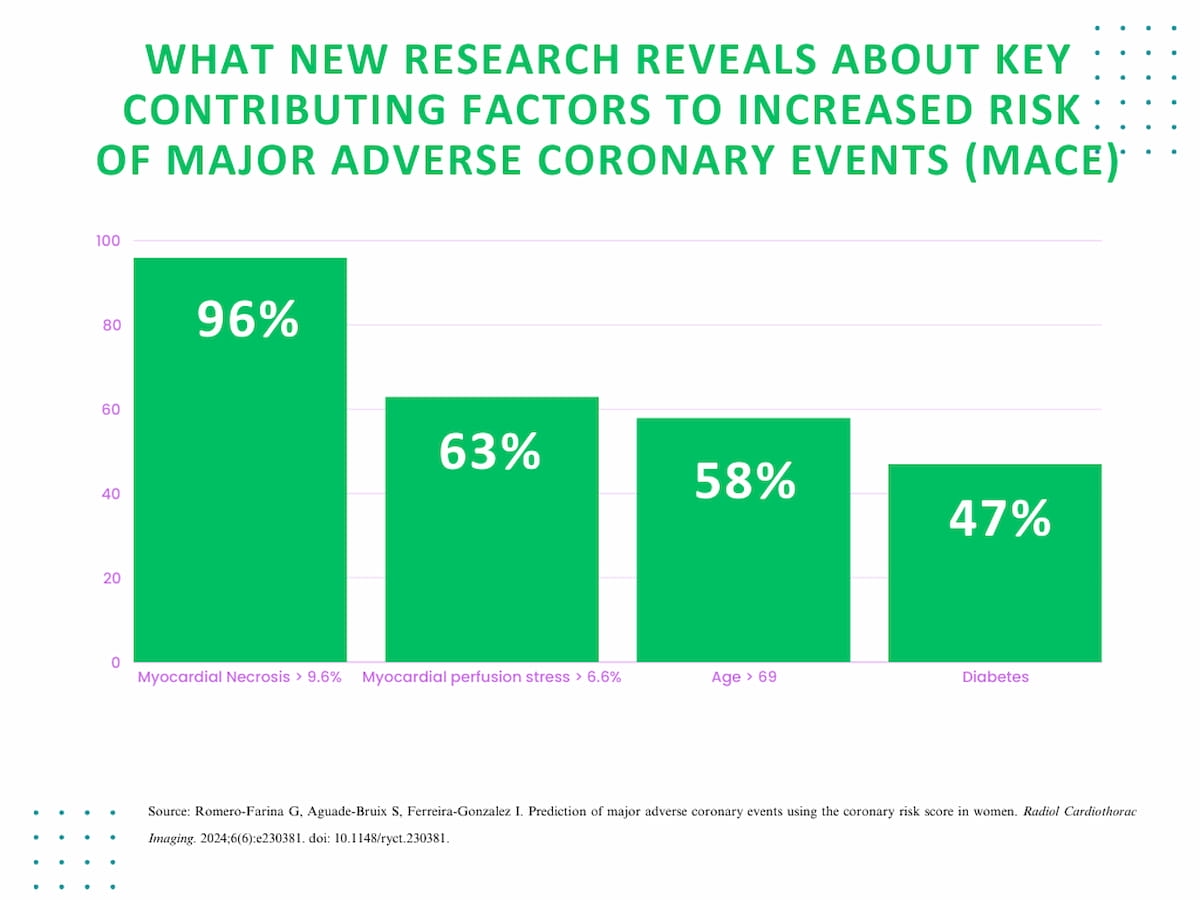An emerging coronary risk scoring system may facilitate improved risk stratification for major adverse coronary events (MACE) in women.
For the retrospective study, recently published in Radiology: Cardiothoracic Imaging, researchers reviewed data from gated single-photon emission computed tomography myocardial perfusion imaging (gSPECT MPI) from 2,226 women (mean age of 66.7) and MACE findings at four-year follow-up exams.
The study authors found that ST-segment depression > 1 mm, myocardial ischemia greater than 5 percent and end-systolic volume index greater than 15 mL were independently associated with more than double the risk for MACE.
Other contributing factors for increased MACE risk included myocardial necrosis > 9.6 percent (96 percent increased risk); myocardial perfusion stress > 6.6 percent (63 percent increased risk); age > 69 years (58 percent increased risk); and diabetes (47 percent increased risk), according to the researchers.
Combining these factors into a COronary Risk Score in WOmen (CORSWO) model, the researchers found the model had a 78 percent area under the curve (AUC) for predicting MACE. Specifically, those who had a moderate CORSWO score between 4 and 6 had a 58 percent higher risk of MACE and women with a high CORSWO score (7-11) had a greater than fourfold higher risk of MACE. For women with very high CORSWO scores (> 11), researchers noted a nearly 14-fold higher MACE risk.
“This study provides new information about a risk score that offers a simple method to predict MACE in female individuals over a mean follow-up of 4 years. CORSWO is an effective tool to stratify the risk for MACE into four risk levels, including high and very high risk, with good accuracy, although requiring multiple imaging variables,” wrote lead study author Guillermo Romero-Farina, M.D., who is affiliated with the Departments of Nuclear Cardiology and Cardiology at the Vall d’Hebron University Hospital and the Vall d’Hebron Research Institute at Autonomous University of Barcelona in Barcelona, Span, and colleagues.
Three Key Takeaways
1. CORSWO as a risk stratification tool: The study introduces the Coronary Risk Score in Women (CORSWO), which effectively stratifies women into four risk levels for MACE with an AUC of 78%. Very high CORSWO scores (>11) were associated with nearly 14-fold higher MACE risk.
2. Key predictors of MACE. Independent risk factors for MACE included ST-segment depression > 1 mm, myocardial ischemia > 5%, and an end-systolic volume index > 15 mL. Additional contributors included myocardial necrosis > 9.6%, myocardial perfusion stress > 6.6%, age > 69 years, and diabetes.
3. Advantages of gSPECT MPI. Compared to exercise electrocardiography, gSPECT MPI offers improved sensitivity (85%-90%) and specificity (70%-75%) for detecting coronary artery disease in women, making it a valuable imaging modality in cases with potential false negatives.
While ST-segment depression is an established marker for detecting CAD in women, the study authors noted the potential for false-negative results and emphasized the merits of gSPECT mPI in these cases.
“gSPECT MPI, with a reported sensitivity ranging from 85% to 90% and reported specificity ranging from 70% to 75%, provides a more sensitive and specific prediction of the presence of CAD than exercise electrocardiography,” noted Romero-Farina and colleagues.
(Editor’s note: For related content, see “Radiology ‘Game-Changer’: FDA Approves PET Agent for Enhanced Detection of Coronary Artery Disease,” “Multicenter Study Shows Capability of AI CCTA Analysis for Predicting Major Adverse Cardiovascular Events” and “Meta-Analysis Shows Superiority of CT Angiography over SPECT and Functional Testing for Obstructive CAD.”)
Beyond the inherent limitations of a retrospective, single tertiary center study, the authors noted that future research is needed to determine if the gSPECT MRI-derived prognostic cutoff values for myocardial perfusion stress, myocardial necrosis and myocardial ischemia would be equivalent to those established with other imaging modalities.
